Apple Inc. Case Study: Evaluating Management, Structure & Culture
VerifiedAdded on 2023/06/09
|12
|3765
|348
Case Study
AI Summary
This case study provides an in-depth analysis of Apple Inc.'s management principles, organizational structure, and culture. It explores key management concepts such as planning, organizing, directing, and controlling, while also examining the impact of organizational structure on the company's performance. The study discusses Apple's hierarchical organizational structure, product-based divisions, and the role of corporate control. Furthermore, it investigates the influence of Apple's organizational culture, focusing on top-notch excellence, secrecy, creativity, innovation, and moderate combativeness. The assignment also addresses management dilemmas faced by managers in enhancing organizational effectiveness, including lack of clear direction, difficulty in unifying teams, failure to develop competencies, poor communication, and lack of awareness. Finally, the case study discusses motivation theories, evaluates alternative leadership styles, and recommends improvements to enhance Apple Inc.'s overall performance. Desklib provides access to similar case studies and solved assignments for students.
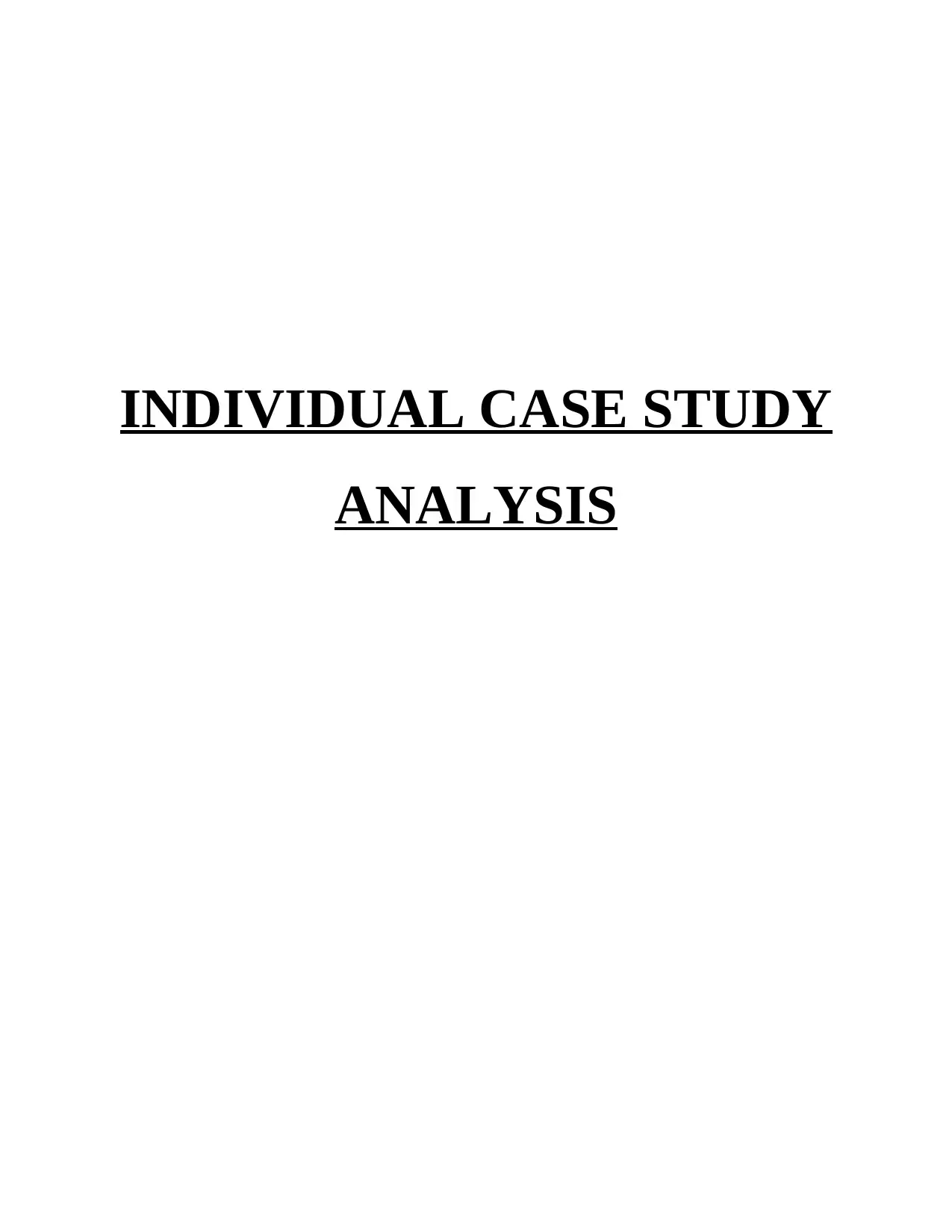
INDIVIDUAL CASE STUDY
ANALYSIS
ANALYSIS
Paraphrase This Document
Need a fresh take? Get an instant paraphrase of this document with our AI Paraphraser
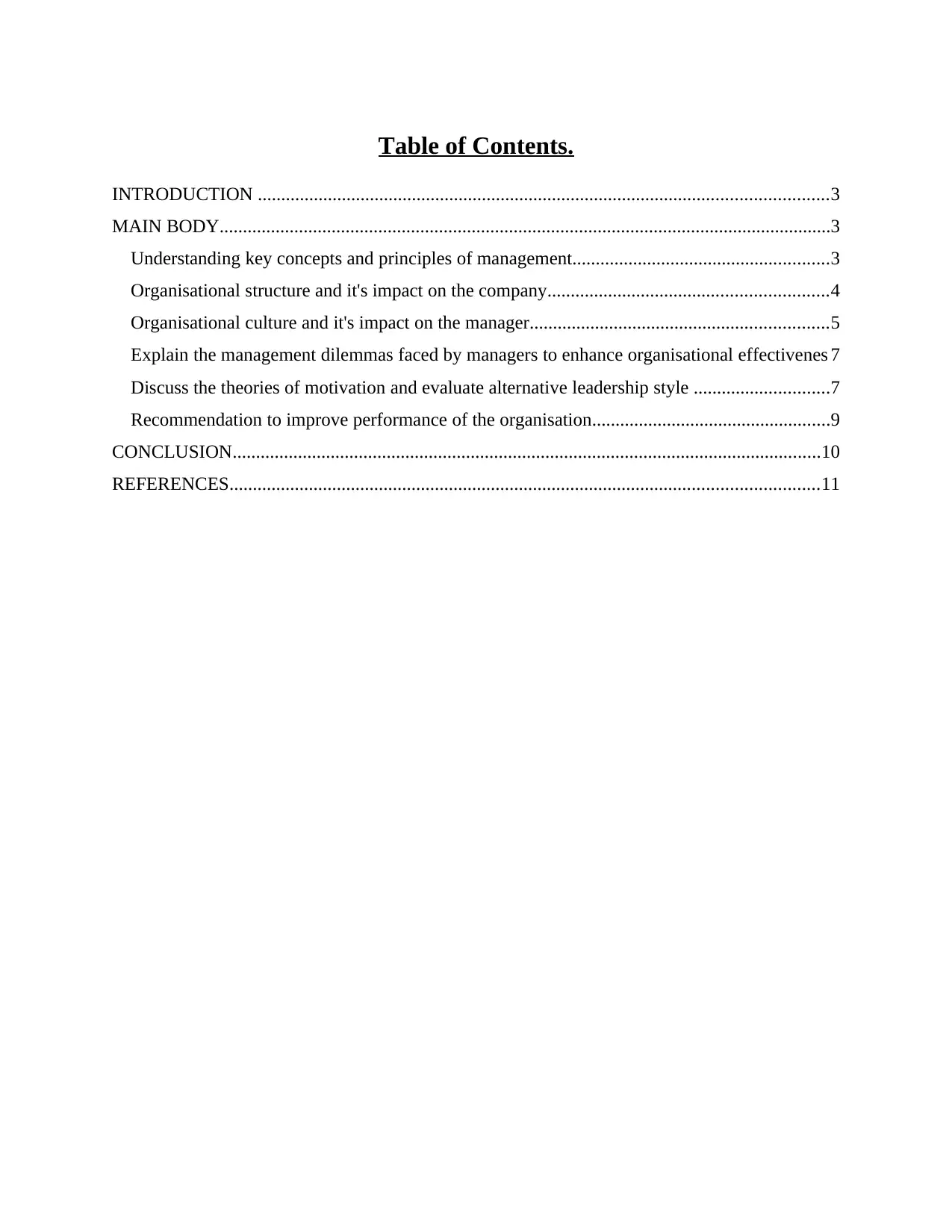
Table of Contents.
INTRODUCTION ..........................................................................................................................3
MAIN BODY...................................................................................................................................3
Understanding key concepts and principles of management.......................................................3
Organisational structure and it's impact on the company............................................................4
Organisational culture and it's impact on the manager................................................................5
Explain the management dilemmas faced by managers to enhance organisational effectivenes 7
Discuss the theories of motivation and evaluate alternative leadership style .............................7
Recommendation to improve performance of the organisation...................................................9
CONCLUSION..............................................................................................................................10
REFERENCES..............................................................................................................................11
INTRODUCTION ..........................................................................................................................3
MAIN BODY...................................................................................................................................3
Understanding key concepts and principles of management.......................................................3
Organisational structure and it's impact on the company............................................................4
Organisational culture and it's impact on the manager................................................................5
Explain the management dilemmas faced by managers to enhance organisational effectivenes 7
Discuss the theories of motivation and evaluate alternative leadership style .............................7
Recommendation to improve performance of the organisation...................................................9
CONCLUSION..............................................................................................................................10
REFERENCES..............................................................................................................................11
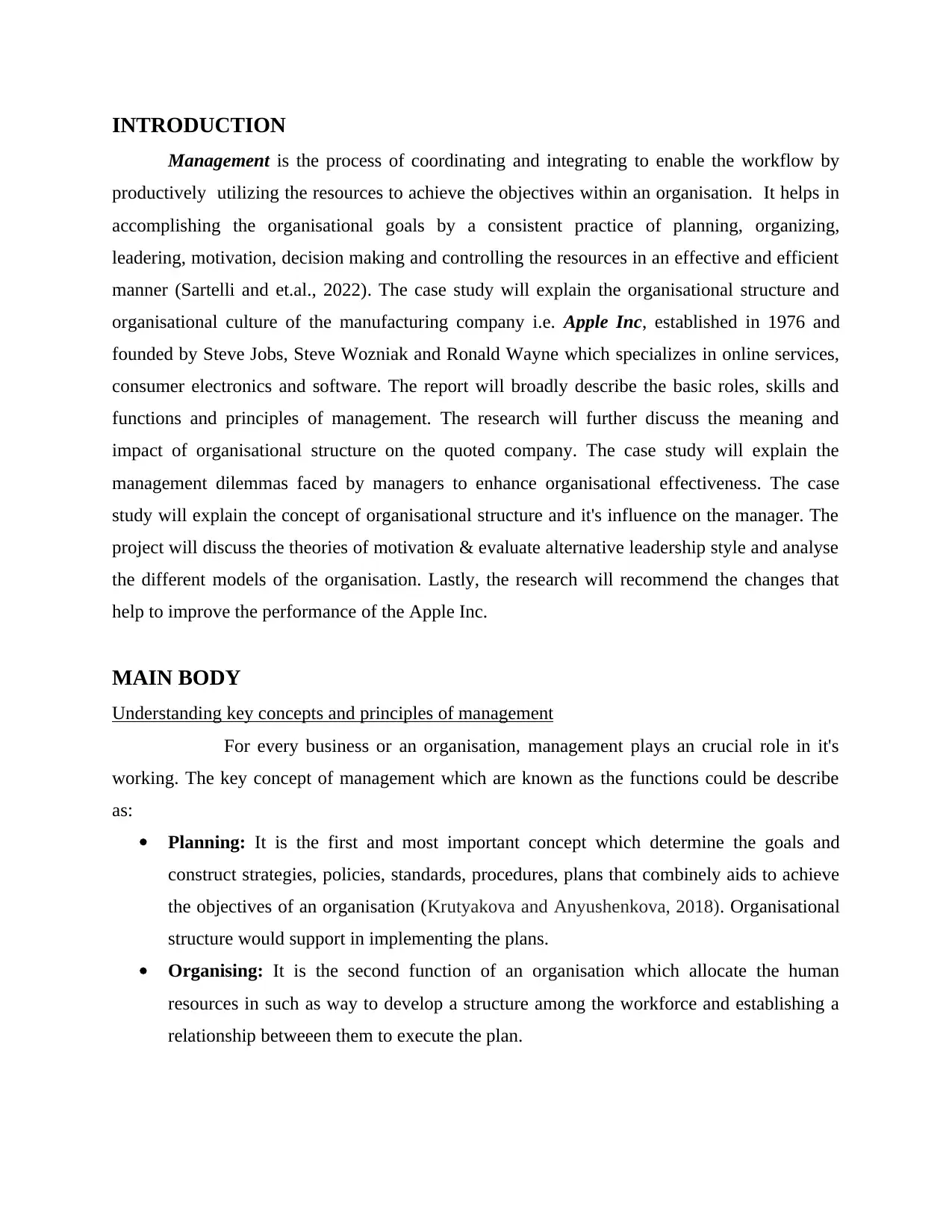
INTRODUCTION
Management is the process of coordinating and integrating to enable the workflow by
productively utilizing the resources to achieve the objectives within an organisation. It helps in
accomplishing the organisational goals by a consistent practice of planning, organizing,
leadering, motivation, decision making and controlling the resources in an effective and efficient
manner (Sartelli and et.al., 2022). The case study will explain the organisational structure and
organisational culture of the manufacturing company i.e. Apple Inc, established in 1976 and
founded by Steve Jobs, Steve Wozniak and Ronald Wayne which specializes in online services,
consumer electronics and software. The report will broadly describe the basic roles, skills and
functions and principles of management. The research will further discuss the meaning and
impact of organisational structure on the quoted company. The case study will explain the
management dilemmas faced by managers to enhance organisational effectiveness. The case
study will explain the concept of organisational structure and it's influence on the manager. The
project will discuss the theories of motivation & evaluate alternative leadership style and analyse
the different models of the organisation. Lastly, the research will recommend the changes that
help to improve the performance of the Apple Inc.
MAIN BODY
Understanding key concepts and principles of management
For every business or an organisation, management plays an crucial role in it's
working. The key concept of management which are known as the functions could be describe
as:
Planning: It is the first and most important concept which determine the goals and
construct strategies, policies, standards, procedures, plans that combinely aids to achieve
the objectives of an organisation (Krutyakova and Anyushenkova, 2018). Organisational
structure would support in implementing the plans.
Organising: It is the second function of an organisation which allocate the human
resources in such as way to develop a structure among the workforce and establishing a
relationship betweeen them to execute the plan.
Management is the process of coordinating and integrating to enable the workflow by
productively utilizing the resources to achieve the objectives within an organisation. It helps in
accomplishing the organisational goals by a consistent practice of planning, organizing,
leadering, motivation, decision making and controlling the resources in an effective and efficient
manner (Sartelli and et.al., 2022). The case study will explain the organisational structure and
organisational culture of the manufacturing company i.e. Apple Inc, established in 1976 and
founded by Steve Jobs, Steve Wozniak and Ronald Wayne which specializes in online services,
consumer electronics and software. The report will broadly describe the basic roles, skills and
functions and principles of management. The research will further discuss the meaning and
impact of organisational structure on the quoted company. The case study will explain the
management dilemmas faced by managers to enhance organisational effectiveness. The case
study will explain the concept of organisational structure and it's influence on the manager. The
project will discuss the theories of motivation & evaluate alternative leadership style and analyse
the different models of the organisation. Lastly, the research will recommend the changes that
help to improve the performance of the Apple Inc.
MAIN BODY
Understanding key concepts and principles of management
For every business or an organisation, management plays an crucial role in it's
working. The key concept of management which are known as the functions could be describe
as:
Planning: It is the first and most important concept which determine the goals and
construct strategies, policies, standards, procedures, plans that combinely aids to achieve
the objectives of an organisation (Krutyakova and Anyushenkova, 2018). Organisational
structure would support in implementing the plans.
Organising: It is the second function of an organisation which allocate the human
resources in such as way to develop a structure among the workforce and establishing a
relationship betweeen them to execute the plan.
⊘ This is a preview!⊘
Do you want full access?
Subscribe today to unlock all pages.

Trusted by 1+ million students worldwide
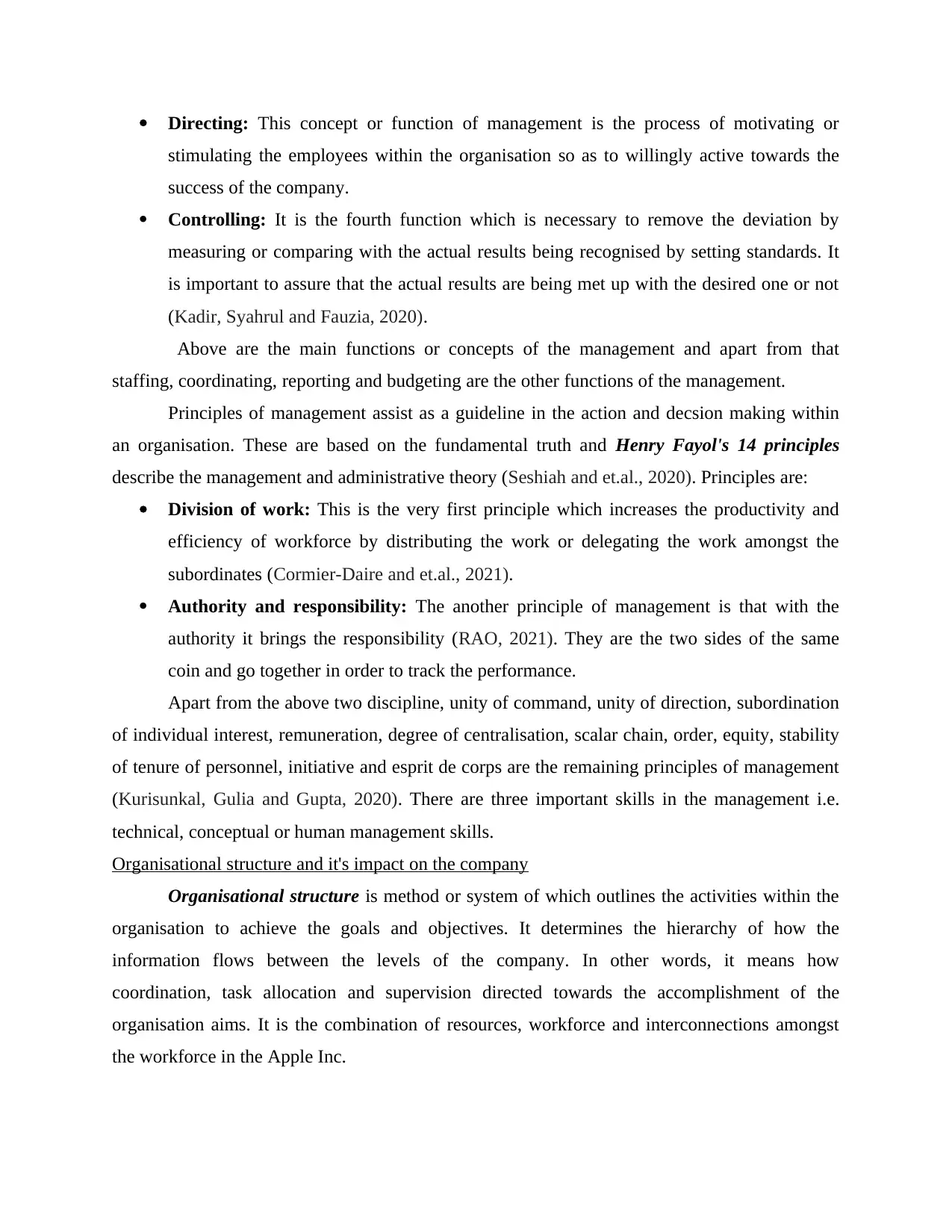
Directing: This concept or function of management is the process of motivating or
stimulating the employees within the organisation so as to willingly active towards the
success of the company.
Controlling: It is the fourth function which is necessary to remove the deviation by
measuring or comparing with the actual results being recognised by setting standards. It
is important to assure that the actual results are being met up with the desired one or not
(Kadir, Syahrul and Fauzia, 2020).
Above are the main functions or concepts of the management and apart from that
staffing, coordinating, reporting and budgeting are the other functions of the management.
Principles of management assist as a guideline in the action and decsion making within
an organisation. These are based on the fundamental truth and Henry Fayol's 14 principles
describe the management and administrative theory (Seshiah and et.al., 2020). Principles are:
Division of work: This is the very first principle which increases the productivity and
efficiency of workforce by distributing the work or delegating the work amongst the
subordinates (Cormier-Daire and et.al., 2021).
Authority and responsibility: The another principle of management is that with the
authority it brings the responsibility (RAO, 2021). They are the two sides of the same
coin and go together in order to track the performance.
Apart from the above two discipline, unity of command, unity of direction, subordination
of individual interest, remuneration, degree of centralisation, scalar chain, order, equity, stability
of tenure of personnel, initiative and esprit de corps are the remaining principles of management
(Kurisunkal, Gulia and Gupta, 2020). There are three important skills in the management i.e.
technical, conceptual or human management skills.
Organisational structure and it's impact on the company
Organisational structure is method or system of which outlines the activities within the
organisation to achieve the goals and objectives. It determines the hierarchy of how the
information flows between the levels of the company. In other words, it means how
coordination, task allocation and supervision directed towards the accomplishment of the
organisation aims. It is the combination of resources, workforce and interconnections amongst
the workforce in the Apple Inc.
stimulating the employees within the organisation so as to willingly active towards the
success of the company.
Controlling: It is the fourth function which is necessary to remove the deviation by
measuring or comparing with the actual results being recognised by setting standards. It
is important to assure that the actual results are being met up with the desired one or not
(Kadir, Syahrul and Fauzia, 2020).
Above are the main functions or concepts of the management and apart from that
staffing, coordinating, reporting and budgeting are the other functions of the management.
Principles of management assist as a guideline in the action and decsion making within
an organisation. These are based on the fundamental truth and Henry Fayol's 14 principles
describe the management and administrative theory (Seshiah and et.al., 2020). Principles are:
Division of work: This is the very first principle which increases the productivity and
efficiency of workforce by distributing the work or delegating the work amongst the
subordinates (Cormier-Daire and et.al., 2021).
Authority and responsibility: The another principle of management is that with the
authority it brings the responsibility (RAO, 2021). They are the two sides of the same
coin and go together in order to track the performance.
Apart from the above two discipline, unity of command, unity of direction, subordination
of individual interest, remuneration, degree of centralisation, scalar chain, order, equity, stability
of tenure of personnel, initiative and esprit de corps are the remaining principles of management
(Kurisunkal, Gulia and Gupta, 2020). There are three important skills in the management i.e.
technical, conceptual or human management skills.
Organisational structure and it's impact on the company
Organisational structure is method or system of which outlines the activities within the
organisation to achieve the goals and objectives. It determines the hierarchy of how the
information flows between the levels of the company. In other words, it means how
coordination, task allocation and supervision directed towards the accomplishment of the
organisation aims. It is the combination of resources, workforce and interconnections amongst
the workforce in the Apple Inc.
Paraphrase This Document
Need a fresh take? Get an instant paraphrase of this document with our AI Paraphraser
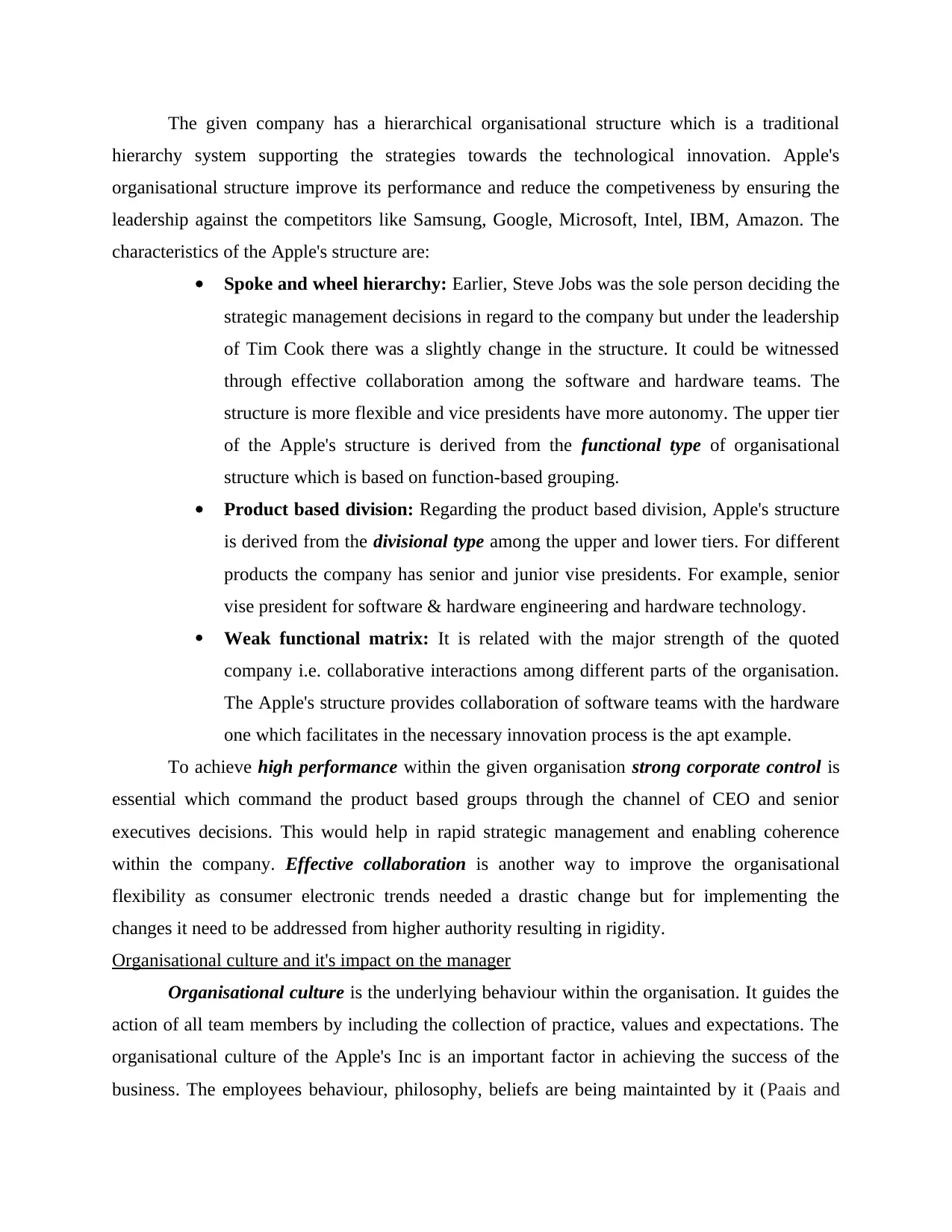
The given company has a hierarchical organisational structure which is a traditional
hierarchy system supporting the strategies towards the technological innovation. Apple's
organisational structure improve its performance and reduce the competiveness by ensuring the
leadership against the competitors like Samsung, Google, Microsoft, Intel, IBM, Amazon. The
characteristics of the Apple's structure are:
Spoke and wheel hierarchy: Earlier, Steve Jobs was the sole person deciding the
strategic management decisions in regard to the company but under the leadership
of Tim Cook there was a slightly change in the structure. It could be witnessed
through effective collaboration among the software and hardware teams. The
structure is more flexible and vice presidents have more autonomy. The upper tier
of the Apple's structure is derived from the functional type of organisational
structure which is based on function-based grouping.
Product based division: Regarding the product based division, Apple's structure
is derived from the divisional type among the upper and lower tiers. For different
products the company has senior and junior vise presidents. For example, senior
vise president for software & hardware engineering and hardware technology.
Weak functional matrix: It is related with the major strength of the quoted
company i.e. collaborative interactions among different parts of the organisation.
The Apple's structure provides collaboration of software teams with the hardware
one which facilitates in the necessary innovation process is the apt example.
To achieve high performance within the given organisation strong corporate control is
essential which command the product based groups through the channel of CEO and senior
executives decisions. This would help in rapid strategic management and enabling coherence
within the company. Effective collaboration is another way to improve the organisational
flexibility as consumer electronic trends needed a drastic change but for implementing the
changes it need to be addressed from higher authority resulting in rigidity.
Organisational culture and it's impact on the manager
Organisational culture is the underlying behaviour within the organisation. It guides the
action of all team members by including the collection of practice, values and expectations. The
organisational culture of the Apple's Inc is an important factor in achieving the success of the
business. The employees behaviour, philosophy, beliefs are being maintainted by it (Paais and
hierarchy system supporting the strategies towards the technological innovation. Apple's
organisational structure improve its performance and reduce the competiveness by ensuring the
leadership against the competitors like Samsung, Google, Microsoft, Intel, IBM, Amazon. The
characteristics of the Apple's structure are:
Spoke and wheel hierarchy: Earlier, Steve Jobs was the sole person deciding the
strategic management decisions in regard to the company but under the leadership
of Tim Cook there was a slightly change in the structure. It could be witnessed
through effective collaboration among the software and hardware teams. The
structure is more flexible and vice presidents have more autonomy. The upper tier
of the Apple's structure is derived from the functional type of organisational
structure which is based on function-based grouping.
Product based division: Regarding the product based division, Apple's structure
is derived from the divisional type among the upper and lower tiers. For different
products the company has senior and junior vise presidents. For example, senior
vise president for software & hardware engineering and hardware technology.
Weak functional matrix: It is related with the major strength of the quoted
company i.e. collaborative interactions among different parts of the organisation.
The Apple's structure provides collaboration of software teams with the hardware
one which facilitates in the necessary innovation process is the apt example.
To achieve high performance within the given organisation strong corporate control is
essential which command the product based groups through the channel of CEO and senior
executives decisions. This would help in rapid strategic management and enabling coherence
within the company. Effective collaboration is another way to improve the organisational
flexibility as consumer electronic trends needed a drastic change but for implementing the
changes it need to be addressed from higher authority resulting in rigidity.
Organisational culture and it's impact on the manager
Organisational culture is the underlying behaviour within the organisation. It guides the
action of all team members by including the collection of practice, values and expectations. The
organisational culture of the Apple's Inc is an important factor in achieving the success of the
business. The employees behaviour, philosophy, beliefs are being maintainted by it (Paais and
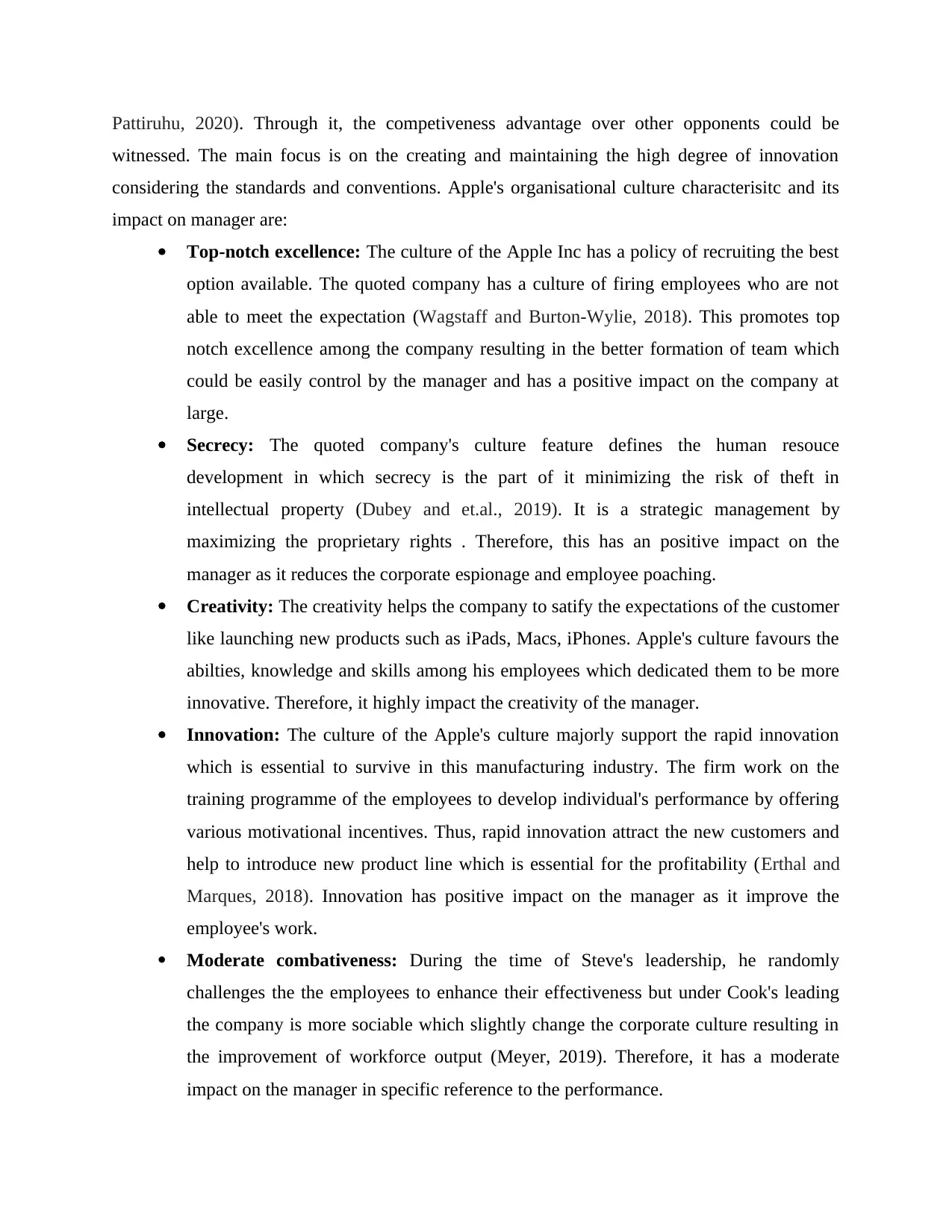
Pattiruhu, 2020). Through it, the competiveness advantage over other opponents could be
witnessed. The main focus is on the creating and maintaining the high degree of innovation
considering the standards and conventions. Apple's organisational culture characterisitc and its
impact on manager are:
Top-notch excellence: The culture of the Apple Inc has a policy of recruiting the best
option available. The quoted company has a culture of firing employees who are not
able to meet the expectation (Wagstaff and Burton-Wylie, 2018). This promotes top
notch excellence among the company resulting in the better formation of team which
could be easily control by the manager and has a positive impact on the company at
large.
Secrecy: The quoted company's culture feature defines the human resouce
development in which secrecy is the part of it minimizing the risk of theft in
intellectual property (Dubey and et.al., 2019). It is a strategic management by
maximizing the proprietary rights . Therefore, this has an positive impact on the
manager as it reduces the corporate espionage and employee poaching.
Creativity: The creativity helps the company to satify the expectations of the customer
like launching new products such as iPads, Macs, iPhones. Apple's culture favours the
abilties, knowledge and skills among his employees which dedicated them to be more
innovative. Therefore, it highly impact the creativity of the manager.
Innovation: The culture of the Apple's culture majorly support the rapid innovation
which is essential to survive in this manufacturing industry. The firm work on the
training programme of the employees to develop individual's performance by offering
various motivational incentives. Thus, rapid innovation attract the new customers and
help to introduce new product line which is essential for the profitability (Erthal and
Marques, 2018). Innovation has positive impact on the manager as it improve the
employee's work.
Moderate combativeness: During the time of Steve's leadership, he randomly
challenges the the employees to enhance their effectiveness but under Cook's leading
the company is more sociable which slightly change the corporate culture resulting in
the improvement of workforce output (Meyer, 2019). Therefore, it has a moderate
impact on the manager in specific reference to the performance.
witnessed. The main focus is on the creating and maintaining the high degree of innovation
considering the standards and conventions. Apple's organisational culture characterisitc and its
impact on manager are:
Top-notch excellence: The culture of the Apple Inc has a policy of recruiting the best
option available. The quoted company has a culture of firing employees who are not
able to meet the expectation (Wagstaff and Burton-Wylie, 2018). This promotes top
notch excellence among the company resulting in the better formation of team which
could be easily control by the manager and has a positive impact on the company at
large.
Secrecy: The quoted company's culture feature defines the human resouce
development in which secrecy is the part of it minimizing the risk of theft in
intellectual property (Dubey and et.al., 2019). It is a strategic management by
maximizing the proprietary rights . Therefore, this has an positive impact on the
manager as it reduces the corporate espionage and employee poaching.
Creativity: The creativity helps the company to satify the expectations of the customer
like launching new products such as iPads, Macs, iPhones. Apple's culture favours the
abilties, knowledge and skills among his employees which dedicated them to be more
innovative. Therefore, it highly impact the creativity of the manager.
Innovation: The culture of the Apple's culture majorly support the rapid innovation
which is essential to survive in this manufacturing industry. The firm work on the
training programme of the employees to develop individual's performance by offering
various motivational incentives. Thus, rapid innovation attract the new customers and
help to introduce new product line which is essential for the profitability (Erthal and
Marques, 2018). Innovation has positive impact on the manager as it improve the
employee's work.
Moderate combativeness: During the time of Steve's leadership, he randomly
challenges the the employees to enhance their effectiveness but under Cook's leading
the company is more sociable which slightly change the corporate culture resulting in
the improvement of workforce output (Meyer, 2019). Therefore, it has a moderate
impact on the manager in specific reference to the performance.
⊘ This is a preview!⊘
Do you want full access?
Subscribe today to unlock all pages.

Trusted by 1+ million students worldwide
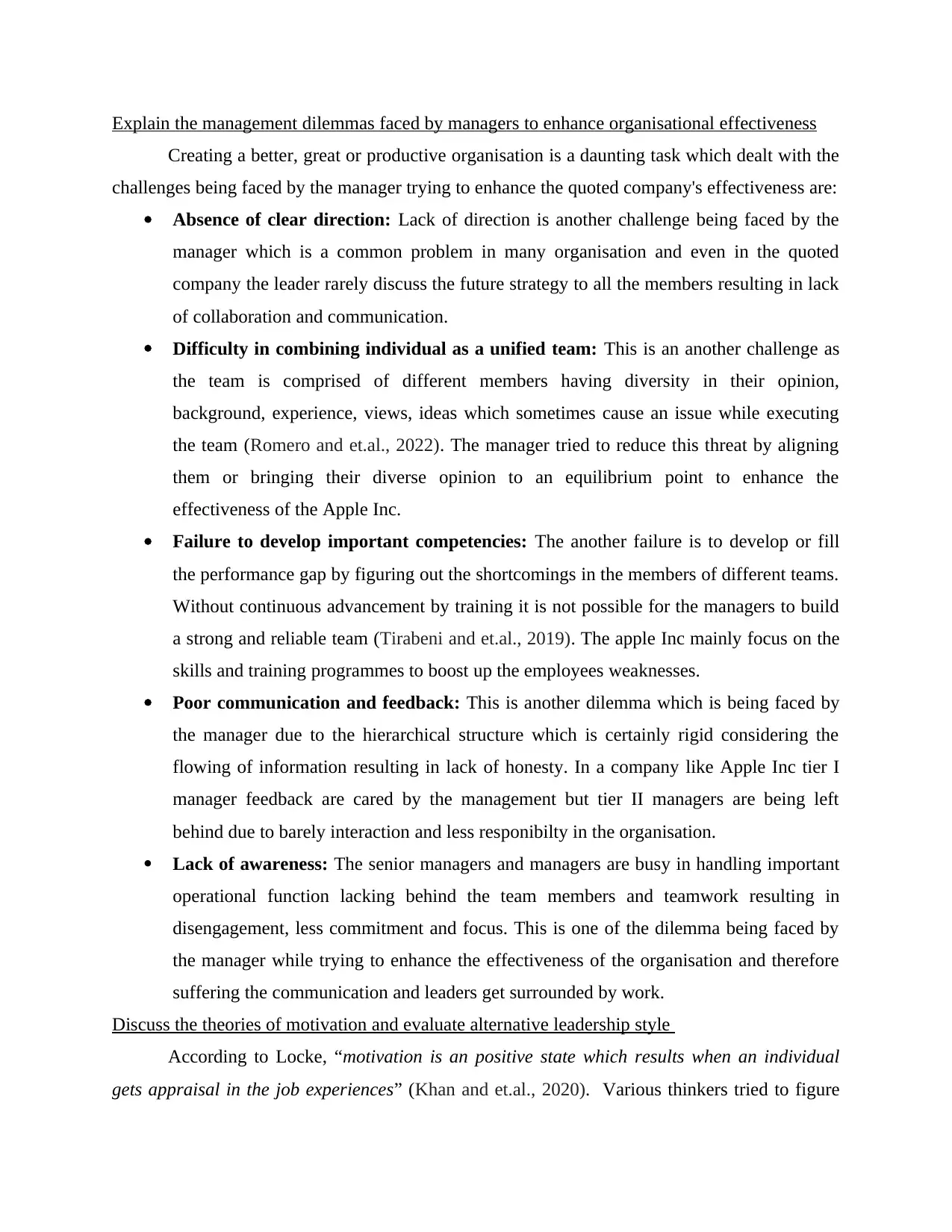
Explain the management dilemmas faced by managers to enhance organisational effectiveness
Creating a better, great or productive organisation is a daunting task which dealt with the
challenges being faced by the manager trying to enhance the quoted company's effectiveness are:
Absence of clear direction: Lack of direction is another challenge being faced by the
manager which is a common problem in many organisation and even in the quoted
company the leader rarely discuss the future strategy to all the members resulting in lack
of collaboration and communication.
Difficulty in combining individual as a unified team: This is an another challenge as
the team is comprised of different members having diversity in their opinion,
background, experience, views, ideas which sometimes cause an issue while executing
the team (Romero and et.al., 2022). The manager tried to reduce this threat by aligning
them or bringing their diverse opinion to an equilibrium point to enhance the
effectiveness of the Apple Inc.
Failure to develop important competencies: The another failure is to develop or fill
the performance gap by figuring out the shortcomings in the members of different teams.
Without continuous advancement by training it is not possible for the managers to build
a strong and reliable team (Tirabeni and et.al., 2019). The apple Inc mainly focus on the
skills and training programmes to boost up the employees weaknesses.
Poor communication and feedback: This is another dilemma which is being faced by
the manager due to the hierarchical structure which is certainly rigid considering the
flowing of information resulting in lack of honesty. In a company like Apple Inc tier I
manager feedback are cared by the management but tier II managers are being left
behind due to barely interaction and less responibilty in the organisation.
Lack of awareness: The senior managers and managers are busy in handling important
operational function lacking behind the team members and teamwork resulting in
disengagement, less commitment and focus. This is one of the dilemma being faced by
the manager while trying to enhance the effectiveness of the organisation and therefore
suffering the communication and leaders get surrounded by work.
Discuss the theories of motivation and evaluate alternative leadership style
According to Locke, “motivation is an positive state which results when an individual
gets appraisal in the job experiences” (Khan and et.al., 2020). Various thinkers tried to figure
Creating a better, great or productive organisation is a daunting task which dealt with the
challenges being faced by the manager trying to enhance the quoted company's effectiveness are:
Absence of clear direction: Lack of direction is another challenge being faced by the
manager which is a common problem in many organisation and even in the quoted
company the leader rarely discuss the future strategy to all the members resulting in lack
of collaboration and communication.
Difficulty in combining individual as a unified team: This is an another challenge as
the team is comprised of different members having diversity in their opinion,
background, experience, views, ideas which sometimes cause an issue while executing
the team (Romero and et.al., 2022). The manager tried to reduce this threat by aligning
them or bringing their diverse opinion to an equilibrium point to enhance the
effectiveness of the Apple Inc.
Failure to develop important competencies: The another failure is to develop or fill
the performance gap by figuring out the shortcomings in the members of different teams.
Without continuous advancement by training it is not possible for the managers to build
a strong and reliable team (Tirabeni and et.al., 2019). The apple Inc mainly focus on the
skills and training programmes to boost up the employees weaknesses.
Poor communication and feedback: This is another dilemma which is being faced by
the manager due to the hierarchical structure which is certainly rigid considering the
flowing of information resulting in lack of honesty. In a company like Apple Inc tier I
manager feedback are cared by the management but tier II managers are being left
behind due to barely interaction and less responibilty in the organisation.
Lack of awareness: The senior managers and managers are busy in handling important
operational function lacking behind the team members and teamwork resulting in
disengagement, less commitment and focus. This is one of the dilemma being faced by
the manager while trying to enhance the effectiveness of the organisation and therefore
suffering the communication and leaders get surrounded by work.
Discuss the theories of motivation and evaluate alternative leadership style
According to Locke, “motivation is an positive state which results when an individual
gets appraisal in the job experiences” (Khan and et.al., 2020). Various thinkers tried to figure
Paraphrase This Document
Need a fresh take? Get an instant paraphrase of this document with our AI Paraphraser
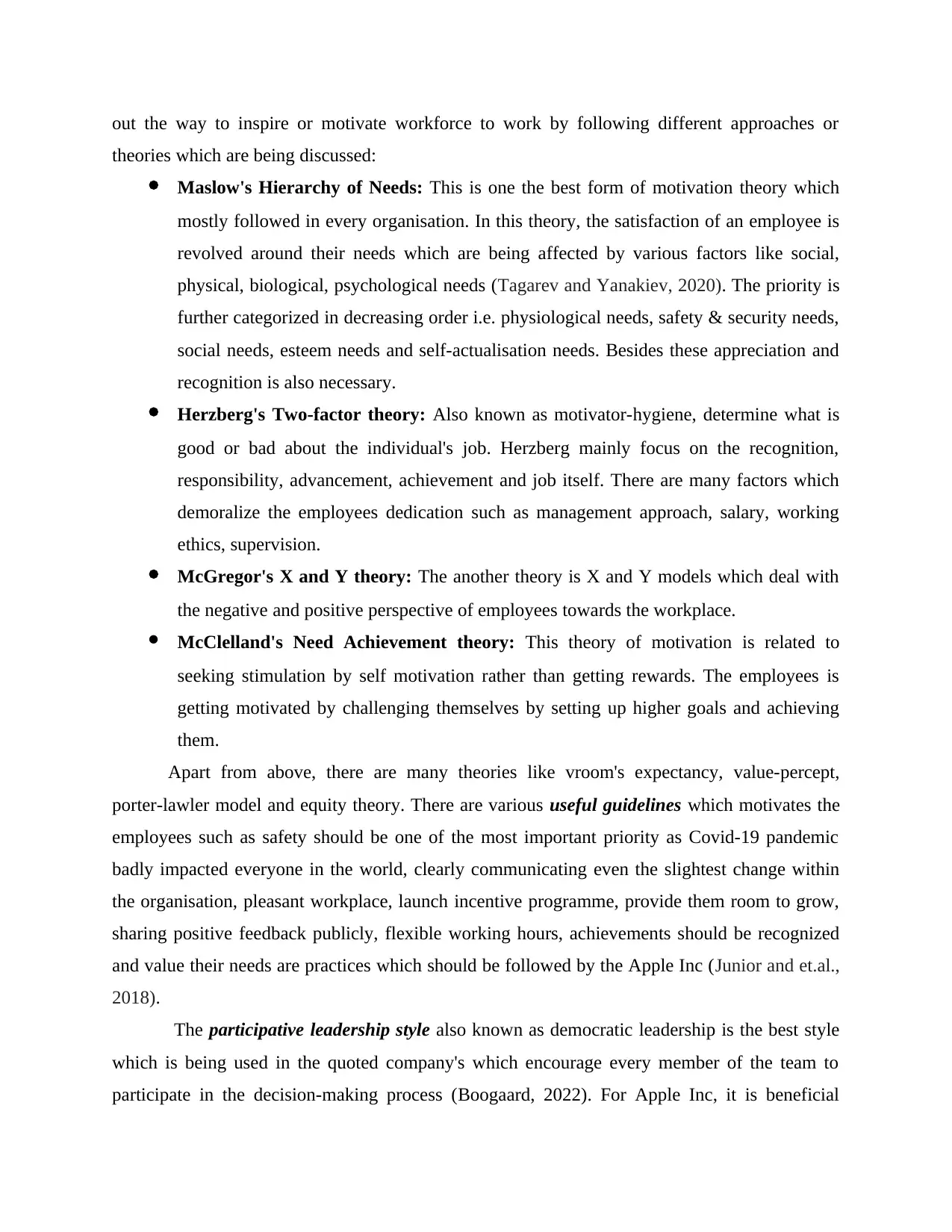
out the way to inspire or motivate workforce to work by following different approaches or
theories which are being discussed:
Maslow's Hierarchy of Needs: This is one the best form of motivation theory which
mostly followed in every organisation. In this theory, the satisfaction of an employee is
revolved around their needs which are being affected by various factors like social,
physical, biological, psychological needs (Tagarev and Yanakiev, 2020). The priority is
further categorized in decreasing order i.e. physiological needs, safety & security needs,
social needs, esteem needs and self-actualisation needs. Besides these appreciation and
recognition is also necessary.
Herzberg's Two-factor theory: Also known as motivator-hygiene, determine what is
good or bad about the individual's job. Herzberg mainly focus on the recognition,
responsibility, advancement, achievement and job itself. There are many factors which
demoralize the employees dedication such as management approach, salary, working
ethics, supervision.
McGregor's X and Y theory: The another theory is X and Y models which deal with
the negative and positive perspective of employees towards the workplace.
McClelland's Need Achievement theory: This theory of motivation is related to
seeking stimulation by self motivation rather than getting rewards. The employees is
getting motivated by challenging themselves by setting up higher goals and achieving
them.
Apart from above, there are many theories like vroom's expectancy, value-percept,
porter-lawler model and equity theory. There are various useful guidelines which motivates the
employees such as safety should be one of the most important priority as Covid-19 pandemic
badly impacted everyone in the world, clearly communicating even the slightest change within
the organisation, pleasant workplace, launch incentive programme, provide them room to grow,
sharing positive feedback publicly, flexible working hours, achievements should be recognized
and value their needs are practices which should be followed by the Apple Inc (Junior and et.al.,
2018).
The participative leadership style also known as democratic leadership is the best style
which is being used in the quoted company's which encourage every member of the team to
participate in the decision-making process (Boogaard, 2022). For Apple Inc, it is beneficial
theories which are being discussed:
Maslow's Hierarchy of Needs: This is one the best form of motivation theory which
mostly followed in every organisation. In this theory, the satisfaction of an employee is
revolved around their needs which are being affected by various factors like social,
physical, biological, psychological needs (Tagarev and Yanakiev, 2020). The priority is
further categorized in decreasing order i.e. physiological needs, safety & security needs,
social needs, esteem needs and self-actualisation needs. Besides these appreciation and
recognition is also necessary.
Herzberg's Two-factor theory: Also known as motivator-hygiene, determine what is
good or bad about the individual's job. Herzberg mainly focus on the recognition,
responsibility, advancement, achievement and job itself. There are many factors which
demoralize the employees dedication such as management approach, salary, working
ethics, supervision.
McGregor's X and Y theory: The another theory is X and Y models which deal with
the negative and positive perspective of employees towards the workplace.
McClelland's Need Achievement theory: This theory of motivation is related to
seeking stimulation by self motivation rather than getting rewards. The employees is
getting motivated by challenging themselves by setting up higher goals and achieving
them.
Apart from above, there are many theories like vroom's expectancy, value-percept,
porter-lawler model and equity theory. There are various useful guidelines which motivates the
employees such as safety should be one of the most important priority as Covid-19 pandemic
badly impacted everyone in the world, clearly communicating even the slightest change within
the organisation, pleasant workplace, launch incentive programme, provide them room to grow,
sharing positive feedback publicly, flexible working hours, achievements should be recognized
and value their needs are practices which should be followed by the Apple Inc (Junior and et.al.,
2018).
The participative leadership style also known as democratic leadership is the best style
which is being used in the quoted company's which encourage every member of the team to
participate in the decision-making process (Boogaard, 2022). For Apple Inc, it is beneficial
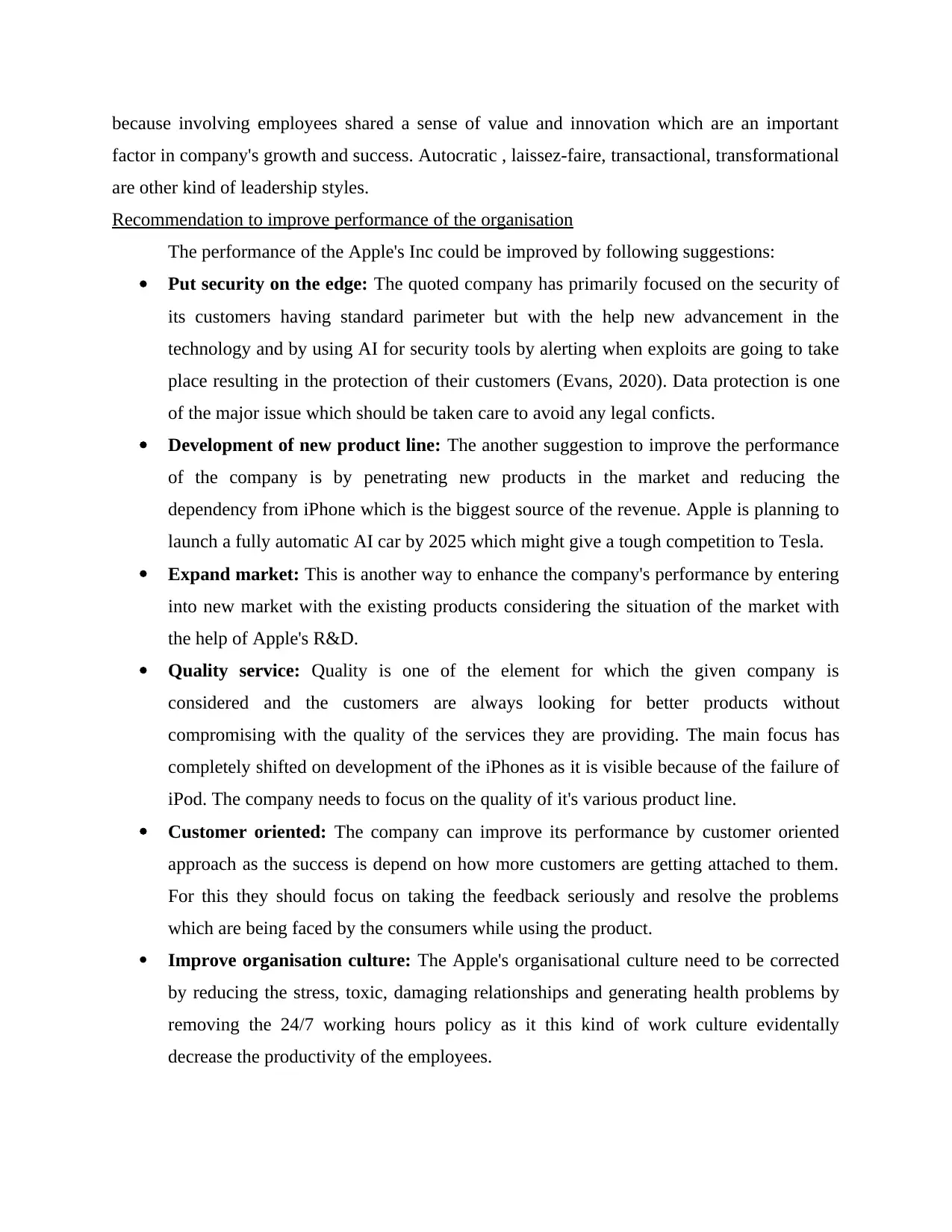
because involving employees shared a sense of value and innovation which are an important
factor in company's growth and success. Autocratic , laissez-faire, transactional, transformational
are other kind of leadership styles.
Recommendation to improve performance of the organisation
The performance of the Apple's Inc could be improved by following suggestions:
Put security on the edge: The quoted company has primarily focused on the security of
its customers having standard parimeter but with the help new advancement in the
technology and by using AI for security tools by alerting when exploits are going to take
place resulting in the protection of their customers (Evans, 2020). Data protection is one
of the major issue which should be taken care to avoid any legal conficts.
Development of new product line: The another suggestion to improve the performance
of the company is by penetrating new products in the market and reducing the
dependency from iPhone which is the biggest source of the revenue. Apple is planning to
launch a fully automatic AI car by 2025 which might give a tough competition to Tesla.
Expand market: This is another way to enhance the company's performance by entering
into new market with the existing products considering the situation of the market with
the help of Apple's R&D.
Quality service: Quality is one of the element for which the given company is
considered and the customers are always looking for better products without
compromising with the quality of the services they are providing. The main focus has
completely shifted on development of the iPhones as it is visible because of the failure of
iPod. The company needs to focus on the quality of it's various product line.
Customer oriented: The company can improve its performance by customer oriented
approach as the success is depend on how more customers are getting attached to them.
For this they should focus on taking the feedback seriously and resolve the problems
which are being faced by the consumers while using the product.
Improve organisation culture: The Apple's organisational culture need to be corrected
by reducing the stress, toxic, damaging relationships and generating health problems by
removing the 24/7 working hours policy as it this kind of work culture evidentally
decrease the productivity of the employees.
factor in company's growth and success. Autocratic , laissez-faire, transactional, transformational
are other kind of leadership styles.
Recommendation to improve performance of the organisation
The performance of the Apple's Inc could be improved by following suggestions:
Put security on the edge: The quoted company has primarily focused on the security of
its customers having standard parimeter but with the help new advancement in the
technology and by using AI for security tools by alerting when exploits are going to take
place resulting in the protection of their customers (Evans, 2020). Data protection is one
of the major issue which should be taken care to avoid any legal conficts.
Development of new product line: The another suggestion to improve the performance
of the company is by penetrating new products in the market and reducing the
dependency from iPhone which is the biggest source of the revenue. Apple is planning to
launch a fully automatic AI car by 2025 which might give a tough competition to Tesla.
Expand market: This is another way to enhance the company's performance by entering
into new market with the existing products considering the situation of the market with
the help of Apple's R&D.
Quality service: Quality is one of the element for which the given company is
considered and the customers are always looking for better products without
compromising with the quality of the services they are providing. The main focus has
completely shifted on development of the iPhones as it is visible because of the failure of
iPod. The company needs to focus on the quality of it's various product line.
Customer oriented: The company can improve its performance by customer oriented
approach as the success is depend on how more customers are getting attached to them.
For this they should focus on taking the feedback seriously and resolve the problems
which are being faced by the consumers while using the product.
Improve organisation culture: The Apple's organisational culture need to be corrected
by reducing the stress, toxic, damaging relationships and generating health problems by
removing the 24/7 working hours policy as it this kind of work culture evidentally
decrease the productivity of the employees.
⊘ This is a preview!⊘
Do you want full access?
Subscribe today to unlock all pages.

Trusted by 1+ million students worldwide
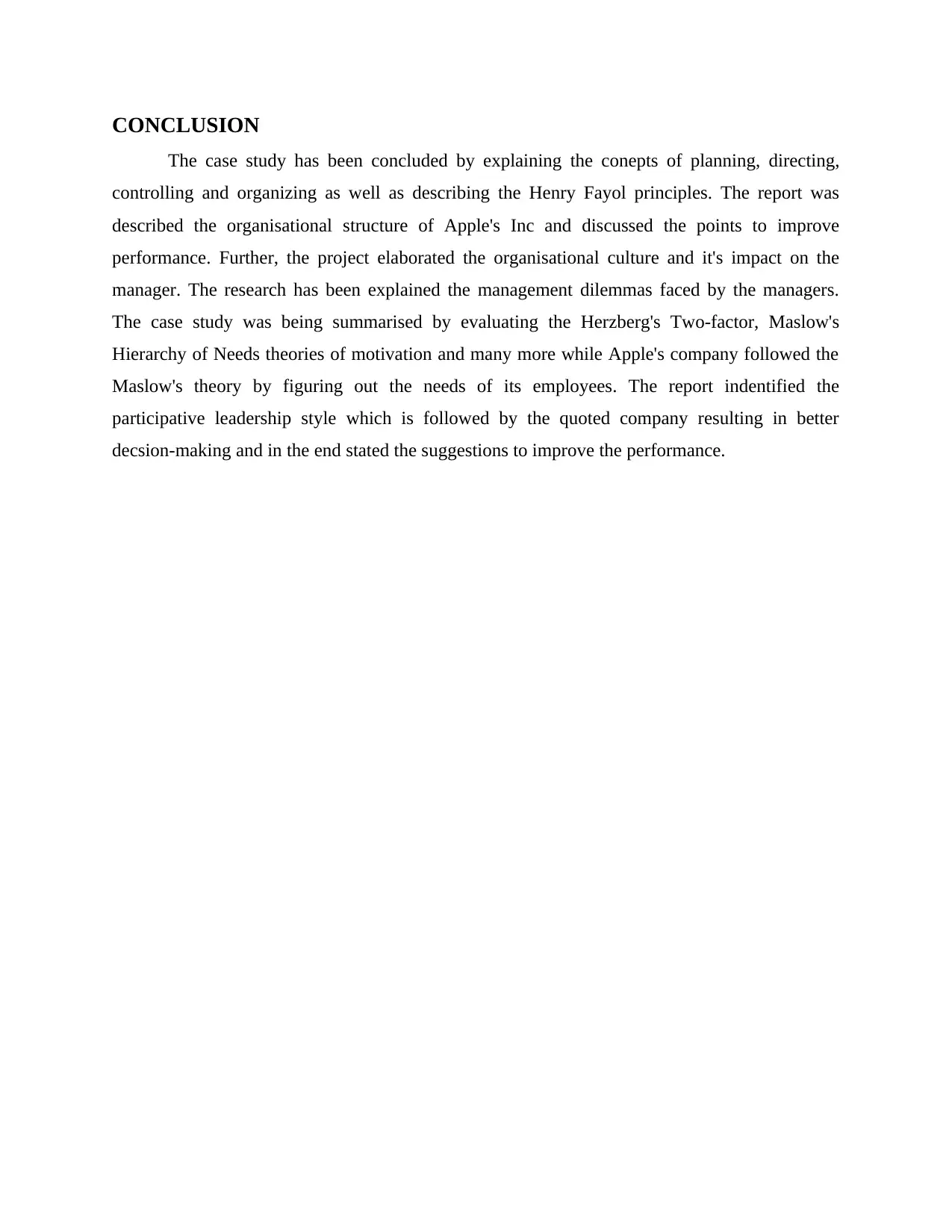
CONCLUSION
The case study has been concluded by explaining the conepts of planning, directing,
controlling and organizing as well as describing the Henry Fayol principles. The report was
described the organisational structure of Apple's Inc and discussed the points to improve
performance. Further, the project elaborated the organisational culture and it's impact on the
manager. The research has been explained the management dilemmas faced by the managers.
The case study was being summarised by evaluating the Herzberg's Two-factor, Maslow's
Hierarchy of Needs theories of motivation and many more while Apple's company followed the
Maslow's theory by figuring out the needs of its employees. The report indentified the
participative leadership style which is followed by the quoted company resulting in better
decsion-making and in the end stated the suggestions to improve the performance.
The case study has been concluded by explaining the conepts of planning, directing,
controlling and organizing as well as describing the Henry Fayol principles. The report was
described the organisational structure of Apple's Inc and discussed the points to improve
performance. Further, the project elaborated the organisational culture and it's impact on the
manager. The research has been explained the management dilemmas faced by the managers.
The case study was being summarised by evaluating the Herzberg's Two-factor, Maslow's
Hierarchy of Needs theories of motivation and many more while Apple's company followed the
Maslow's theory by figuring out the needs of its employees. The report indentified the
participative leadership style which is followed by the quoted company resulting in better
decsion-making and in the end stated the suggestions to improve the performance.
Paraphrase This Document
Need a fresh take? Get an instant paraphrase of this document with our AI Paraphraser
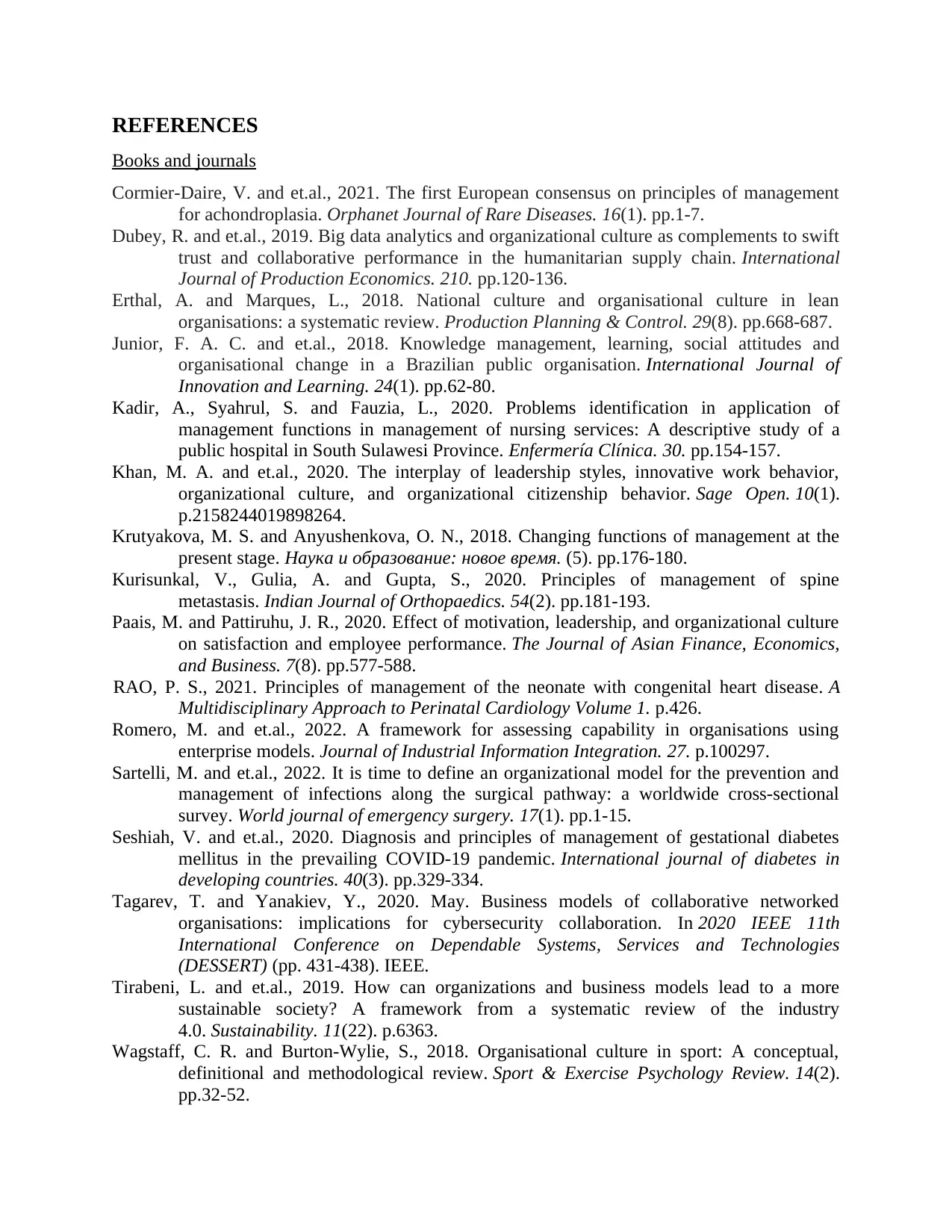
REFERENCES
Books and journals
Cormier-Daire, V. and et.al., 2021. The first European consensus on principles of management
for achondroplasia. Orphanet Journal of Rare Diseases. 16(1). pp.1-7.
Dubey, R. and et.al., 2019. Big data analytics and organizational culture as complements to swift
trust and collaborative performance in the humanitarian supply chain. International
Journal of Production Economics. 210. pp.120-136.
Erthal, A. and Marques, L., 2018. National culture and organisational culture in lean
organisations: a systematic review. Production Planning & Control. 29(8). pp.668-687.
Junior, F. A. C. and et.al., 2018. Knowledge management, learning, social attitudes and
organisational change in a Brazilian public organisation. International Journal of
Innovation and Learning. 24(1). pp.62-80.
Kadir, A., Syahrul, S. and Fauzia, L., 2020. Problems identification in application of
management functions in management of nursing services: A descriptive study of a
public hospital in South Sulawesi Province. Enfermería Clínica. 30. pp.154-157.
Khan, M. A. and et.al., 2020. The interplay of leadership styles, innovative work behavior,
organizational culture, and organizational citizenship behavior. Sage Open. 10(1).
p.2158244019898264.
Krutyakova, M. S. and Anyushenkova, O. N., 2018. Changing functions of management at the
present stage. Наука и образование: новое время. (5). pp.176-180.
Kurisunkal, V., Gulia, A. and Gupta, S., 2020. Principles of management of spine
metastasis. Indian Journal of Orthopaedics. 54(2). pp.181-193.
Paais, M. and Pattiruhu, J. R., 2020. Effect of motivation, leadership, and organizational culture
on satisfaction and employee performance. The Journal of Asian Finance, Economics,
and Business. 7(8). pp.577-588.
RAO, P. S., 2021. Principles of management of the neonate with congenital heart disease. A
Multidisciplinary Approach to Perinatal Cardiology Volume 1. p.426.
Romero, M. and et.al., 2022. A framework for assessing capability in organisations using
enterprise models. Journal of Industrial Information Integration. 27. p.100297.
Sartelli, M. and et.al., 2022. It is time to define an organizational model for the prevention and
management of infections along the surgical pathway: a worldwide cross-sectional
survey. World journal of emergency surgery. 17(1). pp.1-15.
Seshiah, V. and et.al., 2020. Diagnosis and principles of management of gestational diabetes
mellitus in the prevailing COVID-19 pandemic. International journal of diabetes in
developing countries. 40(3). pp.329-334.
Tagarev, T. and Yanakiev, Y., 2020. May. Business models of collaborative networked
organisations: implications for cybersecurity collaboration. In 2020 IEEE 11th
International Conference on Dependable Systems, Services and Technologies
(DESSERT) (pp. 431-438). IEEE.
Tirabeni, L. and et.al., 2019. How can organizations and business models lead to a more
sustainable society? A framework from a systematic review of the industry
4.0. Sustainability. 11(22). p.6363.
Wagstaff, C. R. and Burton-Wylie, S., 2018. Organisational culture in sport: A conceptual,
definitional and methodological review. Sport & Exercise Psychology Review. 14(2).
pp.32-52.
Books and journals
Cormier-Daire, V. and et.al., 2021. The first European consensus on principles of management
for achondroplasia. Orphanet Journal of Rare Diseases. 16(1). pp.1-7.
Dubey, R. and et.al., 2019. Big data analytics and organizational culture as complements to swift
trust and collaborative performance in the humanitarian supply chain. International
Journal of Production Economics. 210. pp.120-136.
Erthal, A. and Marques, L., 2018. National culture and organisational culture in lean
organisations: a systematic review. Production Planning & Control. 29(8). pp.668-687.
Junior, F. A. C. and et.al., 2018. Knowledge management, learning, social attitudes and
organisational change in a Brazilian public organisation. International Journal of
Innovation and Learning. 24(1). pp.62-80.
Kadir, A., Syahrul, S. and Fauzia, L., 2020. Problems identification in application of
management functions in management of nursing services: A descriptive study of a
public hospital in South Sulawesi Province. Enfermería Clínica. 30. pp.154-157.
Khan, M. A. and et.al., 2020. The interplay of leadership styles, innovative work behavior,
organizational culture, and organizational citizenship behavior. Sage Open. 10(1).
p.2158244019898264.
Krutyakova, M. S. and Anyushenkova, O. N., 2018. Changing functions of management at the
present stage. Наука и образование: новое время. (5). pp.176-180.
Kurisunkal, V., Gulia, A. and Gupta, S., 2020. Principles of management of spine
metastasis. Indian Journal of Orthopaedics. 54(2). pp.181-193.
Paais, M. and Pattiruhu, J. R., 2020. Effect of motivation, leadership, and organizational culture
on satisfaction and employee performance. The Journal of Asian Finance, Economics,
and Business. 7(8). pp.577-588.
RAO, P. S., 2021. Principles of management of the neonate with congenital heart disease. A
Multidisciplinary Approach to Perinatal Cardiology Volume 1. p.426.
Romero, M. and et.al., 2022. A framework for assessing capability in organisations using
enterprise models. Journal of Industrial Information Integration. 27. p.100297.
Sartelli, M. and et.al., 2022. It is time to define an organizational model for the prevention and
management of infections along the surgical pathway: a worldwide cross-sectional
survey. World journal of emergency surgery. 17(1). pp.1-15.
Seshiah, V. and et.al., 2020. Diagnosis and principles of management of gestational diabetes
mellitus in the prevailing COVID-19 pandemic. International journal of diabetes in
developing countries. 40(3). pp.329-334.
Tagarev, T. and Yanakiev, Y., 2020. May. Business models of collaborative networked
organisations: implications for cybersecurity collaboration. In 2020 IEEE 11th
International Conference on Dependable Systems, Services and Technologies
(DESSERT) (pp. 431-438). IEEE.
Tirabeni, L. and et.al., 2019. How can organizations and business models lead to a more
sustainable society? A framework from a systematic review of the industry
4.0. Sustainability. 11(22). p.6363.
Wagstaff, C. R. and Burton-Wylie, S., 2018. Organisational culture in sport: A conceptual,
definitional and methodological review. Sport & Exercise Psychology Review. 14(2).
pp.32-52.
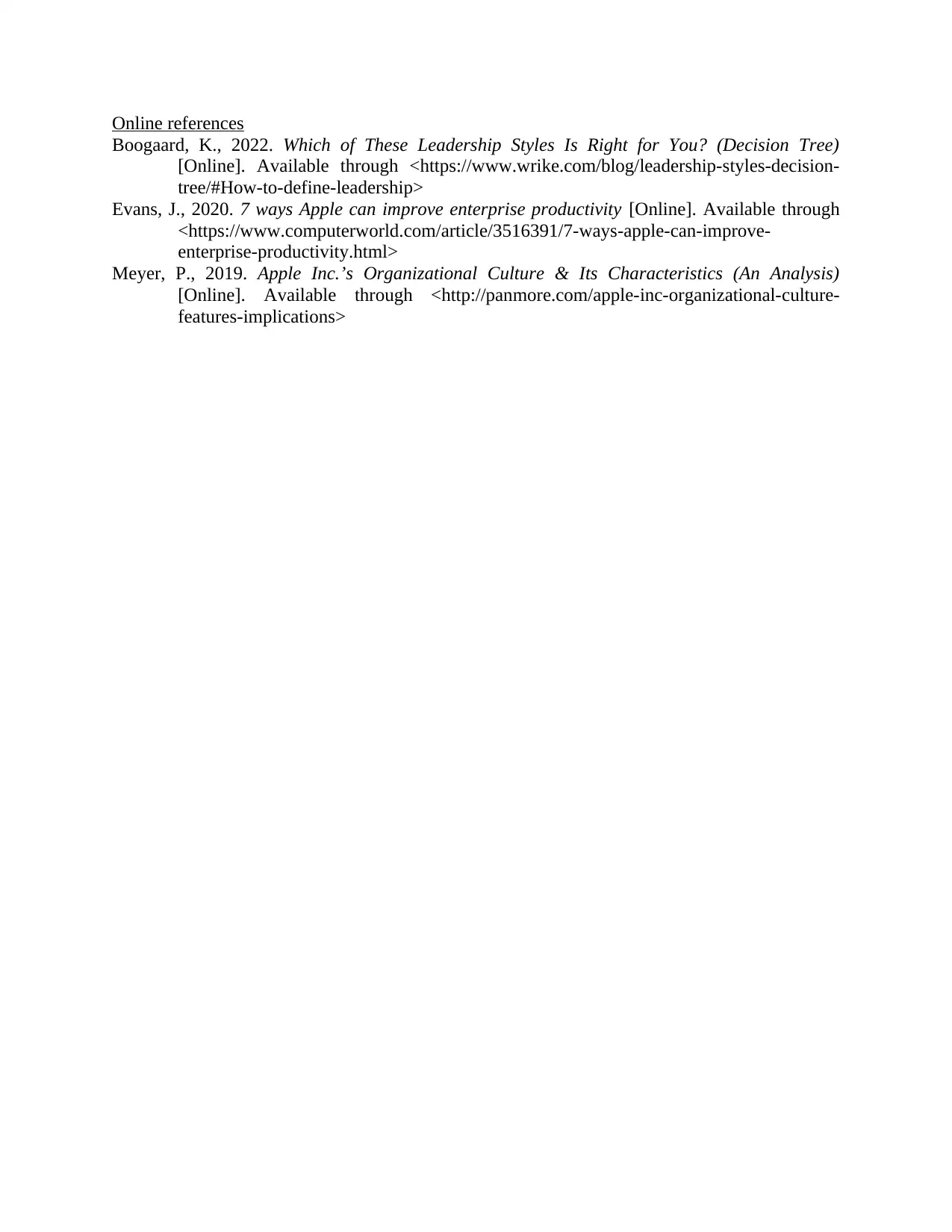
Online references
Boogaard, K., 2022. Which of These Leadership Styles Is Right for You? (Decision Tree)
[Online]. Available through <https://www.wrike.com/blog/leadership-styles-decision-
tree/#How-to-define-leadership>
Evans, J., 2020. 7 ways Apple can improve enterprise productivity [Online]. Available through
<https://www.computerworld.com/article/3516391/7-ways-apple-can-improve-
enterprise-productivity.html>
Meyer, P., 2019. Apple Inc.’s Organizational Culture & Its Characteristics (An Analysis)
[Online]. Available through <http://panmore.com/apple-inc-organizational-culture-
features-implications>
Boogaard, K., 2022. Which of These Leadership Styles Is Right for You? (Decision Tree)
[Online]. Available through <https://www.wrike.com/blog/leadership-styles-decision-
tree/#How-to-define-leadership>
Evans, J., 2020. 7 ways Apple can improve enterprise productivity [Online]. Available through
<https://www.computerworld.com/article/3516391/7-ways-apple-can-improve-
enterprise-productivity.html>
Meyer, P., 2019. Apple Inc.’s Organizational Culture & Its Characteristics (An Analysis)
[Online]. Available through <http://panmore.com/apple-inc-organizational-culture-
features-implications>
⊘ This is a preview!⊘
Do you want full access?
Subscribe today to unlock all pages.

Trusted by 1+ million students worldwide
1 out of 12
Related Documents
Your All-in-One AI-Powered Toolkit for Academic Success.
+13062052269
info@desklib.com
Available 24*7 on WhatsApp / Email
![[object Object]](/_next/static/media/star-bottom.7253800d.svg)
Unlock your academic potential
Copyright © 2020–2025 A2Z Services. All Rights Reserved. Developed and managed by ZUCOL.




